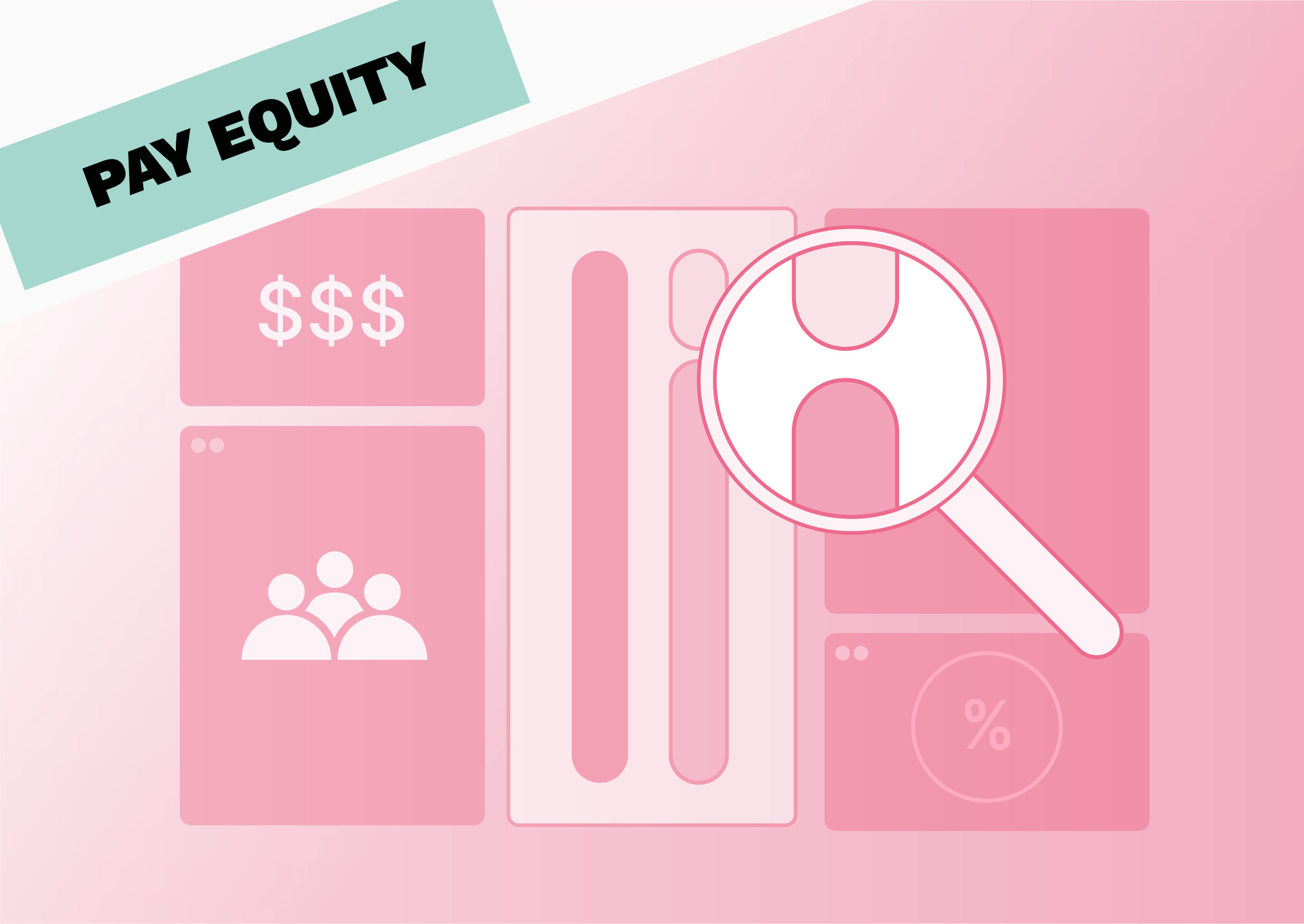How To Conduct a Pay Equity Analysis (And Why You Should)
If you’re serious about paying your employees fairly, a pay equity analysis is the most crucial tool in your belt. After all, you can’t correct inequities if you don’t know they’re there.
But conducting a pay equity analysis is a big job. And if you’ve never done it before, you might be wondering where to start.
Never fear: in this article, we’ll take you through the process step by step, so you can go into your analysis feeling prepared and ready to banish pay inequity from your organisation once and for all.
First, a quick definition:
What is a pay equity analysis?
Pay equity is the idea of paying employees the same if they do the same or substantially similar work. In law, the key concept is ‘equal pay for work of equal value’.
Many factors stand in the way of equal pay, and they’re not all easy to spot at first glance. For example, the way you promote employees or grant pay rises could be biased, even if you’re not aware of it.
A pay equity analysis is a statistical process that allows you to identify inequity in your pay structures by cross-referencing pay with various factors, including gender, age, ethnicity, education, seniority, tenure and performance.
This tells you whether any differences in pay between employees are due to justifiable factors (like better performance or longer tenure) or unjustifiable ones (like the employee’s race or gender).
Internal vs. external pay equity
Before we go any further, we need to define two key concepts: internal equity and external equity.
- External pay equity: This involves comparing your business with the external market to see whether your salaries are in line with industry standards. This ensures your compensation is competitive and helps you to attract and retain talent.
- Internal pay equity: This involves making comparisons between different groups of employees within your business to find out if there are any unjustifiable differences in pay. This allows you to ensure your internal pay practices are not influenced by unconscious bias or discrimination.
In this article, we’ll focus mainly on internal pay equity. But ideally, you should also conduct salary benchmarking to find out whether your salaries are competitive in the wider market — keep reading to the end to find out how we can help with that.
Why should you conduct a regular pay equity analysis?
There are many reasons why conducting regular pay equity analysis is important. For example:
- Improves your compensation and benefits structures
- Demonstrates your commitment to diversity, equity and inclusion
- Helps you attract and retain top talent
- Ensures compliance with local or national laws around pay equity
Most importantly, it’s the right thing to do. In 2024, it’s no longer acceptable to pay some employees less than others just because they belong to a particular group — and not being aware of the problem is no excuse.
How to conduct a pay equity analysis: a step-by-step guide
Ready to conduct your first pay equity analysis? Here are the steps to take:
1. Establish your goals for the analysis
The first step in the process is to determine why you’re doing it in the first place. There are many reasons for conducting a pay equity analysis. For example:
- To eradicate pay inequity in your organisation
- To update your pay practices and policies
- To respond to shareholder demand
- To promote diversity, equity and inclusion
- To ensure you’re compliant with pay equity laws
Of course, you may well have more than one goal. But it’s important to pin down your primary objective before you start, as this will shape the process and methodology you use.
2. Get buy-in from key stakeholders
Conducting a pay analysis requires time, people and money — and that’s just for the process itself. If you uncover any pay inequities, you’ll need to adjust pay to correct them. That’s the whole point of the exercise, after all.
That means you’ll definitely need the buy-in of your company’s leadership team and finance leads before you can move forward. To get it, you might need to present them with some of the benefits of conducting an analysis that we outlined above.
Because conducting a pay equity analysis is a complex process, you’ll likely need input from a few different parties. That means you might also need to secure buy-in from finance, payroll, legal, heads of departments and others to make sure they’ll be willing to collaborate with you.
3. Define "work of equal value" for your organisation
Pay equity is all about paying employees the same salary if they do work of equal value. But you can’t always tell this from a job title alone.
To define what counts as comparable work for your organisation, you’ll need to perform a full job analysis for all employees. That means analysing their roles and determining which ones require similar skills, responsibilities and input and involve working under similar conditions.
For large organisations, you should also consider that employees working in different units or departments might have comparable roles, and group them together accordingly.
Also, be sure to look into how the law defines comparable work in your country or state to make sure you’re legally compliant.
4. Gather the data you need
The next step is to gather the data you need to conduct your analysis. This usually means extracting it from your HRIS or payroll databases, though you might want to include data from other sources too.
The actual data you’ll need to extract depends on your goals and the scope of your analysis. For example, you might decide to collect the following information for each employee:
- Job title and description
- Job level
- Team and department
- Work location
- Performance rating
- Educational level
- Hours worked (i.e. full-time or part-time)
- Starting salary
- Current salary
- Tenure
- Promotions
- Bonuses and benefits
The more data you collect, the more insights you’ll be able to draw from your analysis.
5. Use software to analyse the data
Once you’ve collected all the data you need, it’s time to analyse it. This is the most important step in the process — and the most complicated.
On a basic level, it involves comparing the salaries of employees in each category and looking for disparities between them. Then, you need to find out if these differences can be attributed to discriminatory factors like their age, gender or ethnicity.
The best way to do this is by performing a regression analysis. This is a statistical technique that allows you to see whether a particular variable is having an impact on pay. You do this by analysing all control variables (things that are known to affect pay, like job levels, performance, education and tenure) against independent variables (things that should not have an effect, like gender, race or age).
This tells you whether those independent variables are impacting pay levels, or whether all differences can be explained by legitimate factors like the employee’s seniority or level of responsibility.
If this sounds complicated… it is. If you don’t have internal data analysts who can help you with this stage, you might need to get some assistance from an external expert. But given the benefits of pay equity for your business, your employees and society as a whole, we think this is well worth the investment.
6. Take action to address inequities
When you’ve finished conducting your analysis, you’ll need to address any discrepancies you’ve found.
Of course, the most obvious solution is to raise the pay of anyone that you think is being compensated unfairly.
But you might also want to look into how your processes could be better adapted to ensure employees are paid fairly in the future. For example, you could readdress your recruitment promotion and compensation review processes to make sure you’re giving equal opportunities to all employees.
Because you already got buy-in from the most important stakeholders in step #1, they should be willing to work with you to correct any inequities and ensure everyone is paid what they deserve.
What’s next?
Conducting an internal pay equity analysis allows you to spot and correct unfair pay practices that have crept into your organisation — which can have huge benefits for you as a business.
But if you want to attract and retain top talent, you also need to know that the salaries you’re offering are fair and competitive compared to the external market. For that, you need reliable, real-time data… and we can help.
Our salary benchmarking tool is built on real data from 1000+ companies across Europe. And our intuitive platform makes it easy to quickly compare salaries for any role, in any location.
You can then filter the data you see by industry, headcount and much more, and set your desired market positioning to give you the competitive edge you need.
Want to find out what else Figures can do? Book your free demo to get started.






